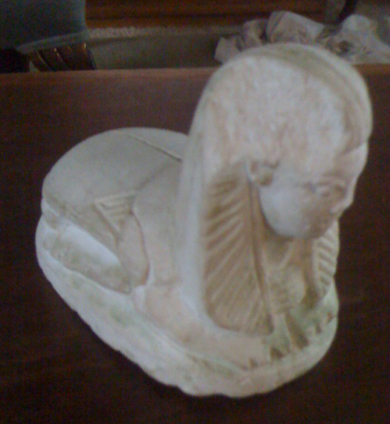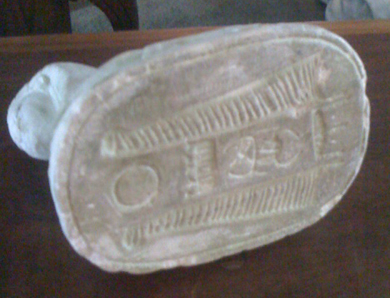 |
|
|||
 |
 |
|||
RINKER ON COLLECTIBLES — Column #1445 Copyright © Harry Rinker, LLC 2014 Questions
and Answers
QUESTION: In cleaning out an old barn, I found a sphinx-like figure. It is 4 inches long, 3 inches wide, and 3 inches tall. The bottom, which is slightly greenish-brown in color, has what appear to be hieroglyphic markings. What do I have? – MM, Reading, PA, Email Question ANSWER: My immediate reaction is that you have a souvenir item sold in a museum gift shop, for example, the Metropolitan Museum of Art, or a tourist-trap shop in a “big” city. I have encountered numerous such examples in my travels. My conclusion is based upon the fact that the object appears to have almost no age or wear. The surface color looks artificial. Based upon my past experiences in such cases, most individuals to whom I offer this opinion have a “you do not know what you are talking about” look on their face. They want the piece to be from ancient Egypt.
When valuing any object, the “what is it” question needs to be answered first. In your case, I recommend taking your sphinx-like figure to the University of Pennsylvania Museum of Archaeology and Anthropology, located on the campus of the University of Pennsylvania. Ask to meet with the Egyptologist. Explain that you only want the piece authenticated. Curators cannot assign value. If you get lucky (do not bet on it) and I am wrong and the piece dates from one of the Egyptian dynasties, there are numerous auction catalogs and websites that will allow you to research value. Although the values are out-of-date, consider consulting Alex G. Malloy’s “Official Guide to Artifacts of Ancient Civilizations,” published by House of Collectibles in 1997. QUESTION: I have a 13 inch high Naugahyde Nauga Monster. Does it have any value? – D, State College, PA ANSWER: The United States Rubber Company developed Naugahyde, a form of artificial leather (plastic leather) made by adding a polyvinyl chloride (PVC) coating to knit fabric. Uniroyal Engineered Products, LLC, located in Stoughton, Wisconsin, is the sole manufacturer of Naugahyde. First trademarked in 1936, the name came from Naugatuck, Connecticut, the location where the product was developed. Advertiser George Lois and designer Kurt Weihs are responsible for the mid-1960s advertising campaign that suggested that Naugahyde came from a skin of the Nauga, a mythical species. When Uniroyal was questioned about its killing of the cute little Naugas, it responded: “We don’t. Naugas shed their hides with no harm to themselves…” Life-size Naugas appeared at numerous trade shows. One visited “The Tonight Show” with Johnny Carson in 1966. An “Invite a Nauga to your next party” advertisement began: “Make the Nauga feel welcome. Punch him in the nose the minute he comes through the door. Spill a Bloody Mary on him. Get him with a pie in the face. Smear chocolate on his chest. Kick him around. His vinyl hide is Naugahyde vinyl fabric. It’s indestructible. / A soapy sponge, and Naugahyde comes clean. Same thing when Naugahyde is on furniture.” The mid-1960s Naugahyde promotional campaign also included 13 to14 inch dolls. The dolls had a tag reading: “I am the Nauga / I am attached to this / because it is covered with my hide… / Naugahyde / vinyl fabric.” The Nauga came in a variety of body tones—blue, brown, gray, green, orange, violet, and yellow. The asking prices for vintage Nauga Monster dolls on eBay vary from $40.00 to $300.00. My impression is that the price listings are based on (1) the best guess of the seller and (2) let’s see what the suckers will pay. Potential buyers will save a great deal of money if they comparison shop. Think conservatively. A realistic secondary market value for your Nauga Monster doll is between $30.00 and $35.00, assuming it is in fine or better condition. The market is flooded with copycat Nauga Monster dolls. The quickest way to identify them is by size. The modern examples are only 10 inches in height. QUESTION: I have a pinback button featuring a black and white bust picture of John L. Lewis. The white border surrounding the picture reads: “JOHN L. LEWIS / STRIKE SOUVENIR.” There is a logo at the bottom of the badge that has a “1938” date. I would like to know its value. – SM, Steubenville, OH ANSWER: The logo on the bottom of your 1 1/4 inch pinback is a union label for Geraghty Co. Being a union advocate, Lewis would have made certain all his products were union made. John Llewellyn Lewis (February 12, 1880 to June 11, 1969) was president of the United Mine Workers of American (UMWA) from 1920 to 1960. In addition, he helped form the Congress of Industrial Organizations (CIO). In 1941, Lewis resigned as head of the CIO. In 1942, he was instrumental in the UMWA’s move from the CIO to the American Federation of Labor (AFL). Lewis was a highly controversial figure. He was an isolationist, breaking with Franklin D. Roosevelt in 1940. He was criticized for constantly calling coal strikes, especially during World War II. He was a demigod to the coal miners, credited for raising wages, pensions, and medical benefits. Lewis called for strikes or work stoppages in 1945, 1946, 1948, and 1949-50. In the end, mechanization and strip mining caused a significant decline in UMWA membership. [For more information, see: http://en.wikipedia.org/wiki/John_L._Lewis] The Lewis portrait on your pinback dates from 1936. Geraghty & Co. was located in Chicago. It made a wide variety of pinback buttons, specializing in labor organizations, “Buy American Products,” and automobiles and automobile products. In 1925, Geraghty published “Advertising Novelties: Badges, Banners, Buttons, Pennants and Signs,” a 61-page catalog. An eBay seller is offering an example of your John L. Lewis pinback for a “Buy It Now” price of $70.00. The description notes: “very good condition; surface irregularities on front noticeable upon a minute ‘touch’ inspection; flip side-age tarnished.” The item has not sold. The picture which accompanied your letter shows that your John L. Lewis pinback has discoloration (faded white to yellowish-tan) and some pinpoint foxing damage on the surface. Given this, a reasonable secondary market value is between $25.00 and $35.00. Part of the difficulty is that today’s young collectors have little interest in union memorabilia and most likely have never heard of or do not remember reading about John L. Lewis in their high school history class. QUESTION: I have an old hexagonal shaped, Sunshine Biscuit tin that pictures a battleship on the lid and additional battleships on the side, one of which is the “U.S.S. Arizona.” What is the value of my tin? – R, Andrea, PA ANSWER: The Loose-Wiles Biscuit Company, manufacturer of Sunshine Biscuits, had plants in Boston, Chicago, Dallas, Kansas City, Minneapolis, and Omaha. Throughout the early part of the 20th century, it was the principal rival of the National Biscuit Company (Nabisco). In March 1946, the Loose-Wiles Biscuit Company changed its name to Sunshine Biscuits, Inc. Keebler Company purchased Sunshine Biscuits in 1999. Keebler was acquired by the Kellogg Company in 2000. [Trivia Quiz: Can you name a former Sunshine Biscuit product that still is being manufactured? In 1937, Loose-Wiles issued its hexagonal American battleships tin. Nine ships were pictured. The cover featured the “U.S.S. Idaho.” The remaining ships included the “U.S.S Gram,” “U.S.S. Narwahl,” “U.S.S. West Virginia,” “U.S.S. Dunlap,” “U.S.S. Arizona,” “U.S.S. Lexington,” “U.S.S. Raleigh,” and “U.S.S. Chicago.” Additional decorative motifs included anchors, lanterns propellers, ropes, and stars. The tin measures 9 1/2 inches across and is 3 1/2 inches height. It contained two and one-half pounds of cookies. Like so many collectibles, values for this tin are “all over the place.” An example listed on Australian eBay in June 13, 2013, with an asking price of $19.99 Australian failed to attract a bid. A current eBay.com seller is asking an opening bid of $35.00. Thus far, there have been no bids. An optimistic Pinterest seller is asking $120.00. The battleships tin had a handle. This must be present to achieve full value. Based on the above, a realistic secondary market value is between $25.00 and $30.00. While normally I do not comment on value, I find this incredibly low. This tin is a great presentation piece. It is a steal below $50.00. Trivia Quiz Answer: Cheez-It snack crackers; Krispy saltine crackers; Krispy Soup & Oyster crackers; Hydrox cookies; and, Hi-Ho Crackers.Harry L. Rinker welcomes questions from readers about
collectibles, those mass-produced items from the twentieth and twenty-first centuries.
Selected letters will be answered in this column.
Harry cannot provide personal answers.
Photos and other material submitted cannot be
returned.
Send your questions to: Rinker on Collectibles, 5955 Mill
Point Court SE, Kentwood, MI 49512.
You also can e-mail your questions to
harrylrinker@aol.com.
Only e-mails containing a full name and mailing address
will be considered.
You can listen
and participate in
WHATCHA GOT?, Harry’s
antiques and collectibles radio call-in show, on Sunday mornings between 8:00 AM
and 10:00 AM Eastern Time.
If you
cannot find it on a station in your area,
WHATCHA GOT?
streams live on the Internet at www.gcnlive.com.
SELL, KEEP OR TOSS?: HOW TO DOWNSIZE A HOME,
SETTLE AN ESTATE, AND APPRAISE PERSONAL PROPERTY
(House of Collectibles, an imprint of Random House Information Group, $17.99),
Harry’s latest book, is available at your favorite bookstore and via
www.harryrinker.com.
|
||||

